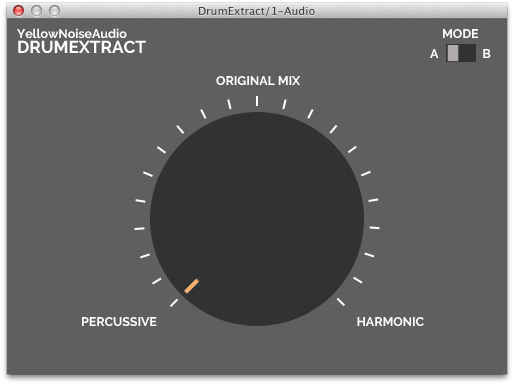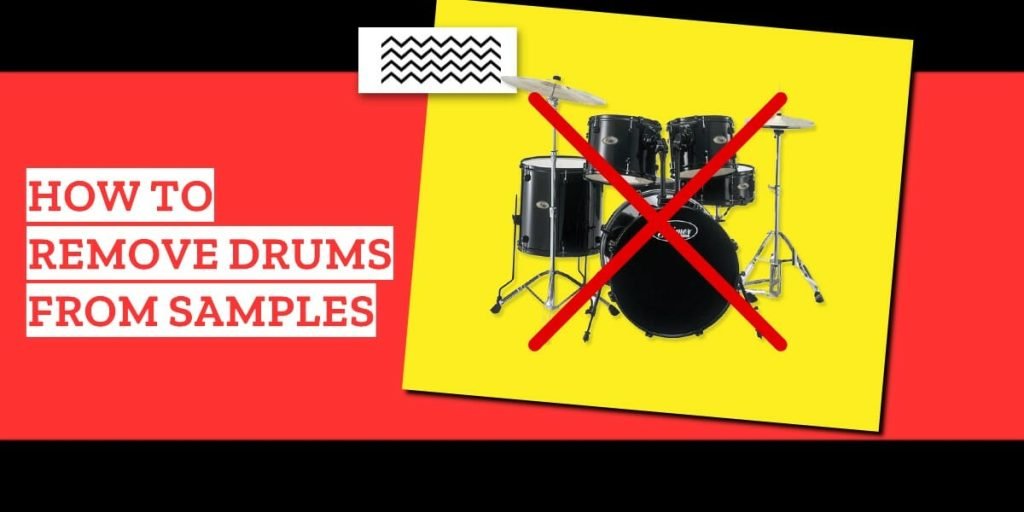The best way to remove drums from a sample is with sound isolation software.
But which one?
There are different types of software you can use to get rid of the drums in your sample, and the best choice depends on how much control you want over the results.
In this article, I’ll show you how you can remove the percussive elements from a song or sample using a few different methods.
To make it easier, I’ve grouped the different options into the following categories:
- Cloud-based sound isolation services
- Specialized audio editing software
- Manual audio editing tools
Cloud-based sound isolation services
Cloud-based services are the easiest way to separate drums from a sample.
These services use AI algorithms to identify sounds in specific frequencies of the audio spectrum. Then they separate these elements in multiple tracks so that you can hear them individually.
As AI algorithms improve, these services are increasingly accurate. All the processing takes place in the cloud, so the results are fast and have no impact on your CPU.
Here are some of the best online services that can help you remove the drums from your samples:
PhonicMind
PhonicMind is one of the first services to offer online drum removal.
Their paid plan is generous. A single subscription gives you an unlimited number of requests per month. The only limitation is the processing speed, which shouldn’t be a problem unless you’re uploading files in bulk.
Using PhonicMind is fairly straightforward. Just upload your audio files, and PhonicMind will separate the mix into individual track stems.
There’s no software to install, and you can cancel the service whenever you want.
Moises.ai
Another popular option is Moises.ai.
With this service, you can also fetch audio from public links like YouTube, SoundCloud and others.
The main benefit of Moises.ai is its mobile app. So if you’ve ever wanted to eliminate the drums from samples while you’re on the go, then this is a great option.
Lalal.ai
Finally, there is Lalal.ai.
The main difference between Lalal.ai and the other options is its pricing structure.
Rather than requiring a monthly subscription, Lalal.ai has a pay-as-you-go model. So you can buy a certain number of credits and use them as needed.
This is ideal if you only plan to use this service occasionally, or you don’t want to be locked into a subscription.
When to use a cloud-based service
The main reason to use a cloud-based service is for simplicity.
If you’re willing to accept whatever result their software gives you, then using a cloud-based service might be the best choice.
Just beware that you lose the ability to customize the output.
With these services, there aren’t many settings you can change, and if the sample you’re trying to edit is incompatible with their algorithm, then there’s nothing you can do about it.
Using a cloud service also means that you have to upload your audio to its servers. So if you work offline, or if you’re concerned about privacy, then this may not be ideal.
Specialized audio editing software
An alternative to using a cloud-based service is to use desktop software or a DAW-supported plugin instead.
Specialized software gives you more tools to control the final result. And if you choose to use a plugin, then you can do all your processing inside your DAW, which makes it more convenient for your sampling workflow.
Here is some of the best software for removing drums from a sample:
Drum Extract by Yellow Noise Audio

DrumExtract is a simple plugin for Mac and Windows that extracts and separates the drums from an audio mix. It’s compatible with all the major DAW’s (i.e. Ableton Live, FL Studio, Logic Pro X, Pro Tools, etc.), and gets better results than traditional tools like EQ, compression, etc.
It’s very easy to use. Once you’ve loaded the plugin onto the audio track, all you have to do is turn the knob to the right to remove the percussive elements.
Its simplicity makes it a great choice for producers who want an easy way to remove drums from inside their DAW.
But this ease of use also comes with a major downside…
If its processing is ineffective for removing the drums of a particular sample, there aren’t any other parameters or options you can use instead.
UNMIX Drums by Zynaptiq
The next option is UNMIX Drums by Zynaptiq, a popular VST plugin for boosting or reducing drums in real-time.
This plugin also works inside your DAW, and allows you to tweak the settings while monitoring its output.
With UNMIX Drums you can alter the sample’s noise reduction, M/S processing, and transient reduction.
Getting the result you want may require some trial and error. But you also get more flexibility for reducing the drums, even with the most challenging mixes.
Demix Essentials by AudioSourceRe
Demix Essentials is a standalone software that brings AudioSourceRe’s advanced sound isolation algorithms right to your desktop.
Similar to the cloud-based options, this software will separate more than just drums. It allows you to isolate the vocals and instruments, too.
In order to process the audio, the software uploads the file to AudioSourceRe’s servers for processing. After it’s finished, it returns the track stems for you to review and tweak.
With Demix Essentials, you get the best of both worlds: cloud-based processing and local audio editing.
It’s the ideal choice if you want to avoid a recurring subscription, but still want the power of a cloud-based algorithm.
RX by Izotope
RX is an industry-grade audio restoration tool by Izotope. It has over 30 tools to isolate, mix and analyze audio.

For removing drums, you can use its Music Rebalance tool, which gives you control over Voice, Bass, Percussion and Other elements in the sample. Just lower the fader of the Percussion knob to reduce the volume of the drums in the mix.
RX is capable of much more than just sound isolation. In fact, if you only intend to remove drums from songs, then RX is a bit overkill. I’d only recommend this option if you need advanced audio repair capabilities on a regular basis.
When to use specialized audio editing software
If you want complete control over your results, you should use one of the software tools in this category.
Removing the drums from some samples will be more difficult than others, and an AI algorithm won’t always be accurate.
Having control over certain parameters will give you the best chance to get accurate results most of the time.
Using desktop software also ensures that you always have access to it. You’ll be able to edit your samples whether you’re online or not.
But using this type of software isn’t cheap. Depending on which tool you choose, you might have to fork over hundreds of dollars for access.
Manual audio editing techniques
So what if you don’t want to use any additional plugins or services? Or you don’t think you need other tools to get the job done?
In those instances, there are a couple “hacks” you can try to remove the percussive elements.
Here they are:
EQ
Sometimes the drums will cut through the mix in isolated areas. When this happens, you can minimize their impact with a parametric equalizer. Try reducing the target frequencies while monitoring playback to ensure it has minimal impact on the rest of the mix.
Most of the time, a song’s percussion is spread across the frequency spectrum, making it difficult to isolate.
You can also try using a multiband equalizer for more control over the shape of the frequencies. Some tools also support M/S processing which allows you to better target specific elements you want to remove from the mix.
Chopping around the transients
If you’re producing hip-hop, another way to remove the drums is to chop parts of the sample that don’t include the drum transients.
This will create a stuttered or choppy effect, but you can fill in the missing transients with your own drums.
Increase the attack of drum hits
Another technique you can try is to apply a fast attack to each sample slice that includes a drum transient.
This will fade the beginning of the sample slice when it is triggered, which subtly removes the sound of the drums.
Of course, you’ll need to experiment with the attack time to find the right balance. But this should at least minimize the effect that the drum transients will have on the mix.
When to use manual audio editing techniques
Not all samples require intense processing. Sometimes you’ll want to keep the drums in the mix, or play over them.
These techniques are great for when you want to maintain the character of the sample, but you need to use some light sound reduction to enhance the cohesion of the beat.
While these techniques may not be perfect, you’ll be surprise by how effective they can be in the right circumstances.
Final Thoughts
Not too long ago, hip-hop producers would avoid samples if the drums interfered with the part they wanted to use. But now you have several options for reducing the drum sounds in your samples.
I recommend choosing the option that makes the most sense for your needs.
If you sample often, and have a consistent need to remove drums from songs, then you should either subscribe to an online service, or get one of the plugins in this article. If you don’t sample often, or prefer to maintain the elements in your samples, then use one of the manual methods instead.
I hope this helps you find a workaround for one of the biggest obstacles in sample-based production.
